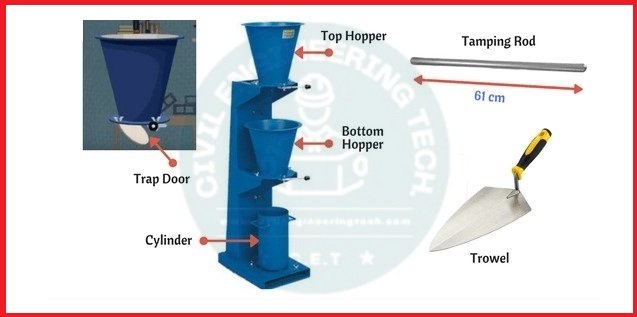
What is Concrete Compaction Factor Test?
The compaction factor test is conducted to determine the workability of the concrete. The slump test may not provide precise results for concrete with low workability, specifically when the slump is less than 50mm. In such cases, the compaction factor test is utilized for concrete mixes with extremely low workability. What is Concrete Compaction factor test.
The compaction factor can be described as the proportion between the weight of concrete that is partially compacted and the weight of concrete that is fully compacted.
The other workability tests are thoroughly described in this section.
- Slump test.
- K Slump test.
- Flow table test.
- Kelly ball test.
- Vee-Bee consistometer test.
- Compaction factor test.
Where we use the low workable concrete?
Low slump concrete is utilized in mass concrete foundations and lightly reinforced sections. The purpose of using low slump concrete is to reduce the formation of thermal stresses resulting from the significant heat of hydration, which can lead to the development of thermal cracks on the concrete surface. By decreasing the water/cement ratio, bleeding and weak zones can be prevented. Nevertheless, the necessary workability is attained through the addition of admixtures.
Read More
Reinforcement Of The Isolated Footing
How To Calculate the Quantity Of Concrete Volume Of Staircase
Find out the quality of Cement on the site
The Compaction factor test Apparatus,
According to the IS1199:1999, the compaction factor test apparatus is comprised of 2 conical hoppers and a bottom cylinder arranged as illustrated in the figure below. A steel rod with a diameter of 1.6cm and a length of 61cm is utilized to compact the concrete, and a weight balance is employed to measure the weight of the concrete.

Procedure for the compaction factor test,
- Utilize M20 grade concrete.
- Prepare the mixture with 1:1.5:3 proportions while incorporating the necessary amount of water based on the Water cement ratio.
- Proceed to mix the fresh concrete.
- Ensure that the inner surfaces of conical hoppers are devoid of moisture and apply grease. Shut the trap door of the upper hopper.
- Subsequently, weigh the empty bottom cylinder and record it as W1.
- Transfer the fresh concrete into the upper conical hopper using the trowel without compacting it.

- Firstly, the trap door of the upper hopper is opened, allowing the concrete to fall into the lower hopper.
- After a brief pause of 2-3 seconds, the operator should verify if all the concrete has transferred from the upper hopper to the lower hopper.
- If not, a gentle tamping action should be applied until all the concrete has successfully moved to the lower hopper.
Read More
How To Measurement of Horizontal Distance Using Auto Level
Estimation of the Material for Concrete
Concrete Slump Test workability Procedure and result
- Subsequently, the trap door of the lower hopper is opened, causing the entire concrete to descend into the cylinder. Any excess concrete on the top surface of the cylinder should be removed using a trowel.
- The weight of the cylinder with the partially filled concrete should be recorded as W2.
- Following this, the cylinder is emptied, and the concrete sample is refilled in 3 layers, with each layer being compacted by delivering 25 blows using the tamping rod.
- This process ensures that the concrete inside the cylinder is thoroughly compacted. Finally, the weight of cylinder with the fully compacted concrete should be measured and noted as W3.
Compaction factor test of the Concrete Formula,

Note
It is crucial to note that the compaction factor of concrete typically falls within the range of 0.7 to 0.95.
This examination is best suited for concrete with a low water-cement ratio.
The weight of fully compacted concrete can be determined by considering the Proportion of materials, specific gravities of materials, and the volume of the cylinder. In my experience, I have noticed that there is minimal variation in the compacting factor value whether the weight is calculated theoretically or determined after 100% compaction.
The compacting factor test is able to determine the intrinsic properties of concrete that are closely linked to the workability standards of concrete. Therefore, it is considered as one of the effective tests for evaluating the workability of concrete.
Other Post
Concrete Slump Test workability Procedure and result
Components of Road Structure
how to Calculate the height of an object using With theodolite
Thumb rule for Civil Engineers
How To Calculate the Asphalt Quantity For Road
Bar Bending Schedule for Beam
What Is The RCC Concrete And Properties of RCC Concrete
What is the Long Wall Short Wall Method





